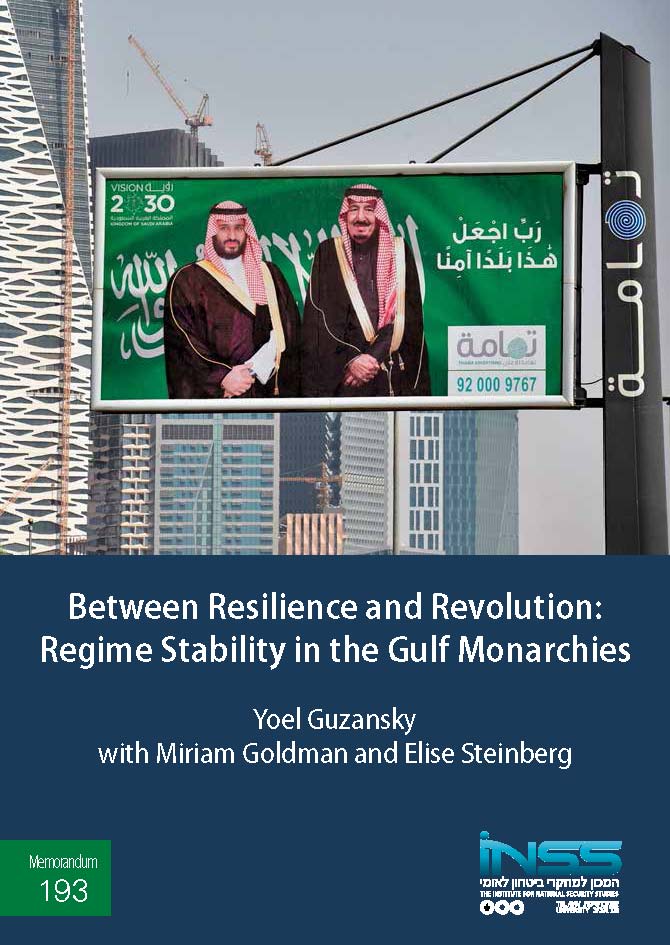Publications
Memorandum No. 193, INSS, July 2019

Predictions of the end of monarchic regimes can be traced back more than half a century, when studies first claimed that due to their “anachronistic nature” monarchies would not withstand the tide of modernization. On balance, the Gulf States, with the exception of Bahrain, have managed to avoid the scale of unrest that reached most of the region’s republics in the last decade. In fact, several Gulf monarchs consolidated their domestic, regional and international power even amid the upheaval. But the monarchies are confronting several challenges, among them the need to rewrite the social contracts between the rulers and the ruled. This study surveys competing explanations for the resilience of the Gulf monarchies, enabling us to establish a framework of analysis to understand outcomes thus far, specifically as they relate to the exceptional resilience of the region’s monarchies when compared to its republics.
With Miriam Goldman and Elise Steinberg
The rise of the Arab republics in the mid-20th century spurred new challenges for the monarchies of the region, particularly those of the Gulf. These challenges resurfaced during the Arab Spring, particularly as waves of protest struck Bahrain, Oman and Saudi Arabia’s Eastern Province. Defying expectations, these regimes demonstrated greater resilience than the Arab republics whose emergence had brought their survivability into question in the first place. While the monarchies of the Gulf indeed face structural challenges, they have thus far adapted to rapid regional change with relative success. In contrast, the rulers of Arab republics, such as Ben Ali of Tunisia, Hosni Mubarak of Egypt, Muammar Qaddafi of Libya and Ali Abdullah Saleh of Yemen, all fell when the regional turmoil struck their borders. In Libya and Yemen the overthrow of leadership certainly failed to secure domestic peace.
The Arab protest movements’ leadership shared a common demographic composition: it was young, urban and educated. In previous decades, that very demographic made up the anti-monarchical movement in the Middle Eastern countries that eventually adopted a republican form of government, e.g., Egypt in 1952, Iraq in 1958 and Iran in 1979. The spread of protests in early 2011 highlighted the congruent sociopolitical tensions that pervaded the wealthy Gulf monarchies: a sizeable youth bloc that suffered from unemployment, lack of equal opportunity and limited options for political participation or reform. Despite the monarchies’ unique governance structure, these same factors spurred protest within their borders all the same.
As detailed in this study, the protests that eventuated within the monarchies unfolded differently in each state, much in accordance with the characteristics unique to each country. These ranged from demonstrations and riots, some of which devolved into violence (e.g., in Bahrain and Oman), to Internet based campaigns and other less confrontational tactics. In Saudi Arabia, for example, the Shiite minority demonstrated and submitted petitions, whereas in the United Arab Emirates (UAE) petitions were submitted but no demonstrations manifested. Qatar was notable more for its response to other countries’ unrest than for facing its own. All, however, responded with some form of repression, this too spanning a spectrum. Some states’ police forces heavily intervened in the protests, as in Bahrain, while others, such as Qatar, acted preemptively, arresting those who spoke out against the ruling family or in favor of civil unrest before any protest could erupt.
On balance, the Gulf States, with the exception of Bahrain, largely managed to avoid the scale of unrest seen in most of the wider region’s republics. In fact, in maintaining stability amid the upheavals, several Gulf monarchs consolidated their domestic, regional and international power. The military intervention of the Gulf Cooperation Council (GCC), be it in Bahrain during the protests or in Yemen currently, is representative of a new, more proactive approach toward moderating the influences of the Arab Spring in general, and Iran in particular, and navigating outcomes in accordance with their individual and joint interests. Yet the purpose of this study is not to examine the impact of the opposition on foreign policy, but rather to explain how the Gulf states remained stable enough that they had the latitude to bring their foreign policies into effect. Especially when compared to the region’s republics, whose leaders were forced out and that devolved into conflict, questions concerning monarchical survival beckon answers – answers that are addressed extensively throughout this work.
====================================================================================================
Contents
Introduction: The Revolution that Has Yet to Manifest
PART I : Is the Arabian Gulf Headed toward Its Own Arab Spring?
Chapter 1: The Arab Spring in the GCC – Background
Chapter 2: The Unique Social, Political and Economic Structures of the Gulf Monarchies
PART II: Sources of Instability among the Gulf Monarchies
Chapter 3: Dependency on Oil
Chapter 4: Militant Sunni Islam
Chapter 5: Shiite Opposition
Chapter 6: Challenges of Succession – Saudi Arabia, Oman and Kuwait
Chapter 7: Virtual Protests
Part III: Theoretical and Empirical Explanations for Regime Stability in the Gulf
Chapter 8: The Theory of the Rentier State
Chapter 9: Religion, Tradition and Government
Chapter 10: Intimidation and Oppression
Chapter 11: External Support
Chapter 12: “Divide and Conquer”
Conclusion: Gulf Monarchical Survival Is Not Unidimensional
Notes


